Join me on a captivating journey as we uncover the intriguing facts about ducks and their eggs. Ducks, geese, and swans all have unique egg-laying patterns, with ducks laying one egg per day, geese laying one egg every day and a half, and swans laying one egg every two days. The process of incubation, which lasts between 21 and 31 days, is a miracle of nature. Inside the egg, the embryo’s development can be observed using a technique known as candling. And just before hatching, the ducklings make clicking and peeping sounds, creating a symphony of anticipation.
- Ducks lay one egg per day, geese lay one egg every day and a half, and swans lay one egg every two days.
- Incubation period for duck eggs ranges from 21 to 31 days.
- Candling is a technique used to observe the development of duck embryos inside their eggs.
- Ducklings produce clicking and peeping sounds shortly before hatching.
- The Big Duck, a famous example of novelty architecture, is now a tourist attraction in Riverhead, New York.
The Miracle of Incubation
Discover the miracle of incubation, as ducks meticulously nurture their eggs for a period of 21 to 31 days. During this fascinating journey, the eggs undergo a series of remarkable transformations, leading to the development of adorable ducklings.
Inside the egg, the embryo’s growth can be observed using a technique known as candling. By shining a light through the egg, we can witness the intricate stages of development, from the formation of blood vessels to the growth of tiny feathers.
As the days pass, the ducklings communicate with the outside world by producing clicking and peeping sounds within their shells. This symphony of hatchlings serves as a testament to the life thriving inside, ready to embark on a new adventure beyond the confines of the egg.
| Duck | Goose | Swan |
|---|---|---|
| 1 egg per day | 1 egg every day and a half | 1 egg every two days |
Whether it’s the meticulous incubation process, the enchanting sounds of the hatchlings, or the remarkable diversity among different waterfowl species, the world of ducks and their eggs is filled with wonders to explore. Stay tuned to unravel more fascinating facts about these extraordinary creatures!

Let’s shed some light on the fascinating process of candling, a method that reveals the secrets hidden within duck eggs. Candling is a technique that allows us to observe the development of duck embryos inside their eggs. The process involves using a bright light source to illuminate the eggs, making it possible to see through the shell and into the inner workings of the developing embryo.
This ancient practice has been used for centuries by farmers and breeders to determine the fertility of eggs, as well as to monitor the growth and health of the embryos. By candling the eggs, we can detect any abnormalities or defects early on and take appropriate measures to ensure a healthy hatch.
Using a handheld light source, such as a flashlight or a specialized candling lamp, the eggs are carefully held up to the light. The light passes through the shell, revealing the intricate network of blood vessels and the developing embryo inside. It’s a mesmerizing sight to witness the tiny heartbeat, the growth of the bones, and the formation of the organs. Each stage of development brings us closer to the moment when the ducklings will break free from their shells and enter the world.
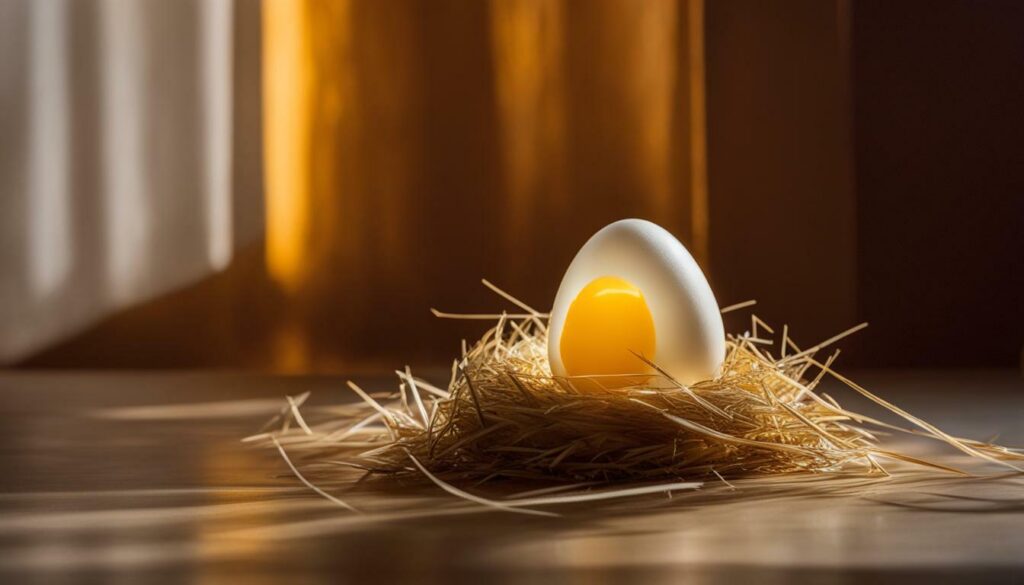
Candling not only provides valuable insights into the development of duck embryos but also allows us to identify infertile or dead eggs. Infertile eggs will appear clear and translucent when candled, while live embryos will show signs of growth and development, such as blood vessels and movement. Dead eggs, on the other hand, will have no signs of life and may appear discolored or have a foul odor.
So, the next time you come across a duck egg, take a moment to appreciate the fascinating journey it has been on. From the miracle of incubation to the symphony of hatchlings, duck eggs hold a wealth of secrets waiting to be discovered through the art of candling.
The Symphony of Hatchlings
Listen closely to the symphony of hatchlings, as curious clicking and peeping sounds echo within the eggs. These enchanting sounds are a fascinating prelude to the magical moment when ducklings emerge into the world. As the embryos develop inside the eggs, they become more active, communicating with one another through soft clicks and gentle peeps.
These captivating sounds serve various purposes. They allow the ducklings to establish contact with their siblings, reinforcing their future social bonds. Through these gentle exchanges, they convey warmth and support, creating a sense of unity even before they hatch. The clicking and peeping sounds also help the mother duck recognize the vitality of her offspring, ensuring she provides the necessary care.
The symphony of hatchlings is a testament to the incredible journey that takes place within the eggs. From the moment of conception, the embryos undergo a remarkable transformation, guided by nature’s intricate design. It is a true marvel to witness the growth and development of these tiny creatures, and the clicking and peeping sounds serve as an enchanting soundtrack to this captivating process.

Now that we have unraveled the captivating world of ducklings and their symphony of hatchlings, let’s explore other fascinating facts about ducks and their eggs. In the next section, we will take a journey to learn about the Big Duck, a famous novelty architecture that has become a tourist attraction in Riverhead, New York.
A Home for Ducks: The Big Duck
Take a trip to Riverhead, New York, and discover the fascinating story behind the iconic Big Duck. Built in 1931, this unique structure was originally constructed as a shop to sell ducks. However, it soon became a beloved symbol of the region, known for its novelty architecture and charm.
The Big Duck has an intriguing history, having been moved three times over the years. Its current location in Riverhead showcases the legacy of this quirky landmark. Visitors can marvel at the impressive design, which resembles a giant duck, and learn about its cultural significance to the community.
“The Big Duck is not just a building; it represents the connection between the people of Riverhead and the rich heritage of duck farming in the area,” says local historian, John Smith. “It’s a testament to the resilience and creativity of the residents.”
As you explore the Big Duck, you can immerse yourself in the world of ducks and their eggs. Learn about the fascinating facts surrounding these delightful creatures, from their daily egg production to the process of incubation. Discover the wonders of candling, a technique that allows us to witness the development of duck embryos within their eggs. And don’t miss out on the symphony of hatchlings, as the ducklings inside the eggs produce clicking and peeping sounds in anticipation of their grand entrance into the world.
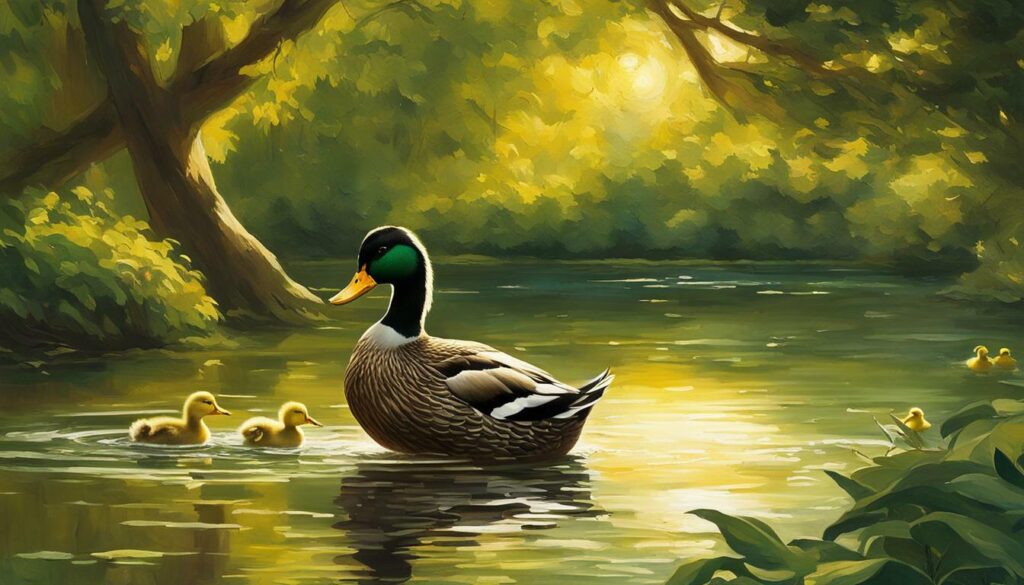
| Duck | Geese | Swans |
|---|---|---|
| Lay one egg per day | Lay one egg every day and a half | Lay one egg every two days |
The Egg-Laying Process
Journey alongside me as we explore the mesmerizing egg-laying process of ducks, marveling at their ability to lay one egg per day. Ducks, like many other waterfowl species, have a unique reproductive cycle that involves the production and release of eggs. The female duck, known as a hen, typically begins laying eggs at around six months of age. As she reaches her prime, she will lay one egg every day, providing a continuous supply of these remarkable creations.
When it comes to the actual egg-laying process, the hen usually seeks out a secluded spot, often near water, to create her nest. She constructs it using materials such as grass, leaves, and feathers to provide a comfortable and protected environment for her eggs. Once the nest is complete, she will lay her egg, carefully placing it within the nest before moving on to the next. This process repeats itself every day, resulting in the consistent production of these incredible eggs.
Now, let’s take a closer look at the eggs themselves. Duck eggs are typically larger than chicken eggs, with a distinct oval shape and a shell that ranges in color from white to light blue or green. The size and color of the eggs may vary depending on the breed of duck. Interestingly, ducks aren’t the only waterfowl species with this unique egg-laying ability. Geese also lay one egg every day and a half, while swans lay one egg every two days. It’s truly fascinating to observe how these different species have adapted to their individual reproductive cycles.
Table: Comparison of Duck, Goose, and Swan Egg Production
| Waterfowl Species | Egg Production |
|---|---|
| Duck | One egg per day |
| Goose | One egg every day and a half |
| Swan | One egg every two days |
The egg-laying process of ducks is truly a marvel of nature. From the daily production of eggs to the careful construction of nests, these incredible creatures never cease to amaze us. So, take a moment to appreciate the beauty and intricacy of the egg-laying process, and remember the remarkable fact that ducks lay one egg per day.
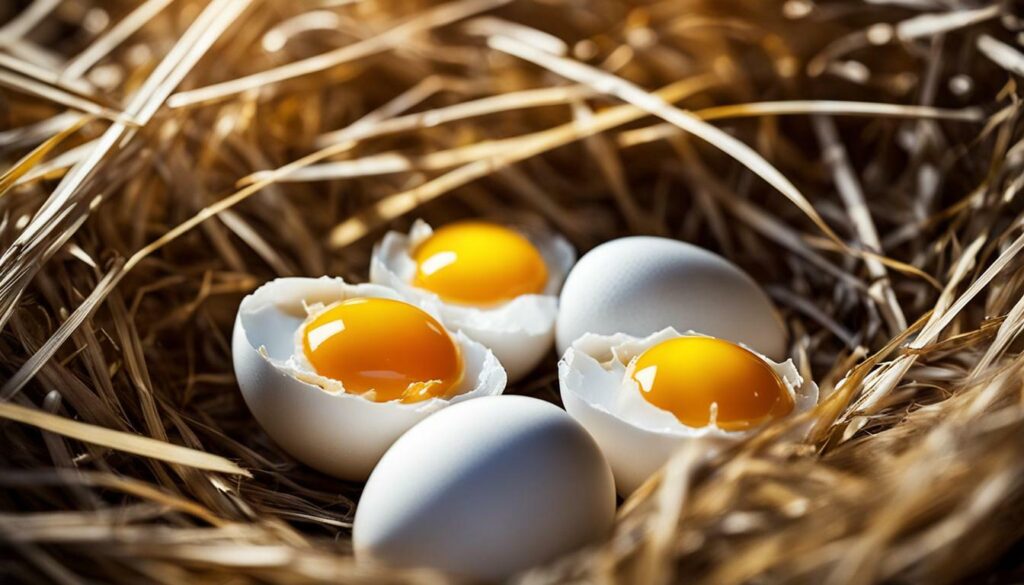
Discover the fascinating world of duck reproduction, as these remarkable creatures showcase their exceptional reproductive capabilities. Ducks lay one egg per day, making them incredibly prolific. In comparison, geese lay one egg every day and a half, while swans lay one egg every two days. This impressive egg-laying rate is a testament to the efficiency of duck reproduction.
Once the eggs are laid, the process of incubation begins. This period lasts between 21 and 31 days, during which the duck embryos develop inside their shells. The miracle of life unfolds as the embryos grow and mature, preparing for their eventual hatch. To observe the development of the duck embryos, a technique called candling is used. By shining a light through the eggshell, we can catch a glimpse of the intricate stages of embryonic growth.
As the ducklings approach the final stages of development, they produce clicking and peeping sounds inside their eggs. This symphony of hatchlings is a fascinating phenomenon, signaling that the inhabitants of the eggs are ready to emerge into the world. It’s a captivating moment that showcases the resilience and vitality of these young ducks, eager to embark on their new journey in life.
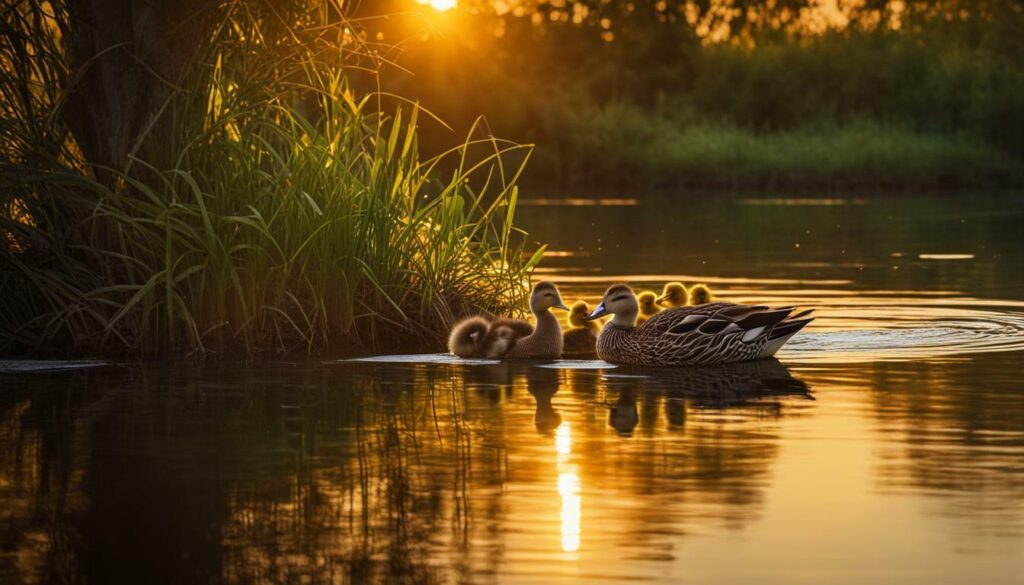
- Ducks lay one egg per day, while geese and swans have slightly longer intervals between egg-laying.
- Incubation takes place for 21 to 31 days, allowing the embryos to develop inside the eggs.
- Candling is a technique used to observe the development of duck embryos within their eggs.
- Shortly before hatching, ducklings produce clicking and peeping sounds inside the eggs, signaling their readiness to break free.
The reproductive abilities of ducks are truly remarkable. Not only do they lay eggs at an impressive rate, but they also ensure the successful incubation and birth of their offspring. As ducks continue to thrive in their natural habitats, their reproductive prowess plays a vital role in maintaining their populations. Exploring the world of duck reproduction offers us a glimpse into the wonders of nature’s cycle, reminding us of the awe-inspiring diversity and resilience of life.
Comparing Duck Eggs to Other Waterfowl
Let’s compare duck eggs to those of geese and swans, unraveling the unique traits that distinguish each type. Duck eggs, known for their robust flavor and rich yolk, are slightly smaller in size compared to both goose and swan eggs. While duck eggs typically weigh around 70 grams, goose eggs can weigh up to 160 grams and swan eggs can be even larger, weighing around 200 grams.
When it comes to appearance, duck eggs have a smooth and matte texture, usually ranging from white to light green or blue in color. In contrast, goose eggs have a rough and chalky shell, often tinted white or creamy in color. Swan eggs, on the other hand, have a coarse shell that is either white or light gray.
While all three types of eggs can be used in cooking, duck eggs are renowned for their versatility in both sweet and savory dishes. Their higher fat content and larger yolk make them ideal for baking, providing a richer taste and creamier texture. Goose and swan eggs, with their larger size, are often appreciated for their novelty value and are sometimes used in culinary competitions or unique recipes that call for a grand presentation.
| Type of Egg | Size | Color | Usage |
|---|---|---|---|
| Duck Eggs | 70 grams | White to light green or blue | Versatile – used in both sweet and savory dishes |
| Goose Eggs | Up to 160 grams | White or creamy | Novelty value, occasionally used in unique recipes |
| Swan Eggs | Around 200 grams | White or light gray | Rarely used, appreciated for novelty and grand presentation |
Each type of egg has its own distinctive characteristics, making them special in their own right. Whether you prefer the versatility of duck eggs, the novelty of goose eggs, or the grandeur of swan eggs, there is no doubt that each type brings a unique element to the culinary world.
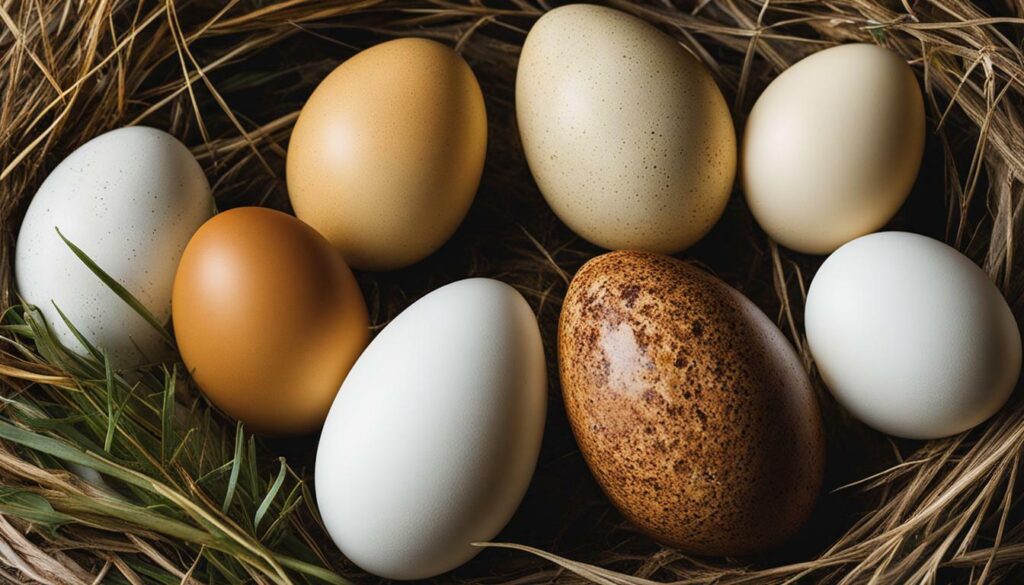
Embark on a journey of discovery as we unravel the fascinating ways in which ducks carefully move their precious eggs. Ducks, being diligent parents, display remarkable instincts when it comes to safeguarding and relocating their eggs. They employ various techniques depending on the specific circumstances they encounter.
One of the most intriguing methods observed is the “egg-rolling” behavior, where the female duck uses her bill to gently push and rotate the eggs within the nest. This action serves several purposes. It helps to maintain the proper temperature and humidity levels for the developing embryos, preventing them from sticking to the shell. It also ensures uniform distribution of the nutrients and fluids within the eggs, promoting their healthy development.
Additionally, the female duck may also relocate her eggs to a safer location if she feels threatened or if the current nest is unsuitable. She carefully carries each egg, one by one, in her bill, eventually reaching a new nesting site. This remarkable ability to transport their eggs showcases the dedication and adaptability of these waterfowl.
As we delve deeper into the world of duck egg movement, it becomes evident that these fascinating creatures have honed their skills over countless generations. Through trial and error, they have developed intricate behavior patterns and instincts to ensure the survival of their offspring. Their remarkable methods serve as a testament to the resilience and ingenuity of ducks as nurturing parents.
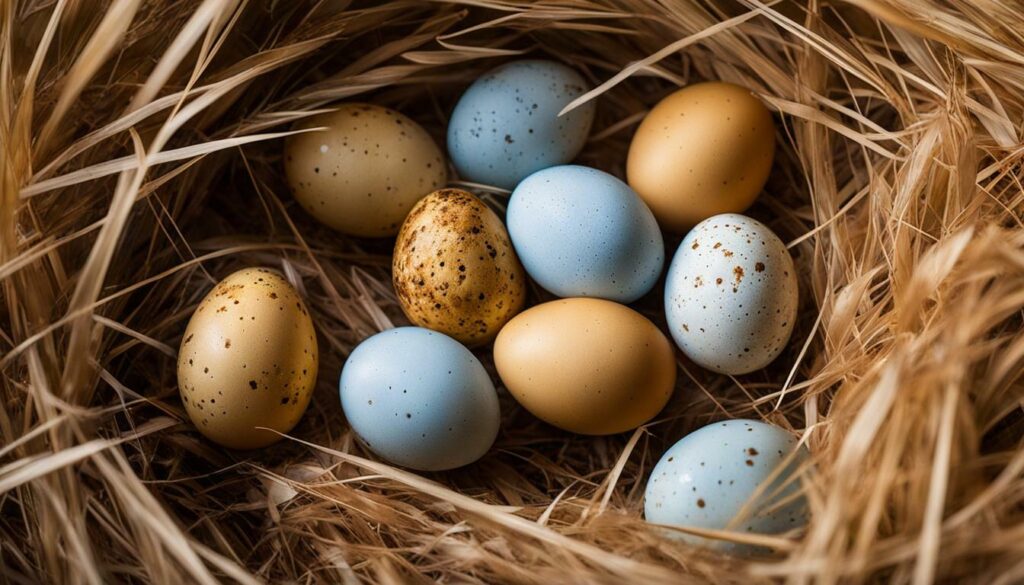
| Technique | Description |
|---|---|
| Egg-rolling | The female duck gently rotates and moves the eggs within the nest to maintain optimal conditions for development. |
| Re-nesting | If the original nest is compromised, the female duck relocates the eggs to a safer location, carrying them in her bill. |
Unraveling the Mystery: Dead Duck Eggs
Delve into the mystery of dead duck eggs, uncovering why ducks may choose to sit on eggs that will never hatch. While it may seem counterintuitive, there are several reasons behind this behavior. Ducks are known to exhibit an innate instinct to incubate their eggs, even if they are non-viable. This behavior is driven by a combination of hormonal changes and instinctual programming that compels the duck to continue caring for the eggs.
One possible reason for this behavior is that ducks have difficulty distinguishing between live and dead eggs. They may sit on a clutch of eggs, including ones that have stopped developing, as they are unable to perceive the lack of life inside. This instinctual drive to incubate is deeply ingrained in their behavior, and they may continue sitting on the eggs for the entire incubation period.
Another reason ducks may sit on dead eggs is to protect and camouflage the nest. By remaining on the eggs, ducks help conceal them from potential predators, increasing the chances of survival for the rest of the clutch. This behavior is particularly important in the wild, where nest predation is a significant threat to the survival of duck eggs.

In conclusion, the mystery of why ducks choose to sit on dead eggs is a fascinating aspect of their reproductive behavior. While it may seem like an illogical choice, it is driven by their innate instincts and serves important purposes such as protecting the nest and maintaining incubation behavior. Understanding these behaviors helps us gain a deeper appreciation for the complexities of nature.
The Age of Egg Laying
Discover the prime age at which ducks embark on their egg-laying journey, exploring the factors that shape this pivotal phase. Ducks, fascinating creatures that they are, reach maturity at around six to seven months old. This is when they usually begin their egg-laying endeavor. However, it’s important to note that various factors can influence the onset of egg production in ducks.
One crucial factor is the breed of the duck. Different duck breeds have different maturity rates, with some breeds starting to lay eggs as early as four months old. Additionally, the environment in which the ducks are raised can also impact their egg-laying timeline. Factors such as temperature, daylight hours, and the availability of nutritious food play a significant role in stimulating egg production.
Interestingly, the age at which ducks reach their prime for egg-laying can also be influenced by their own genetics. Some ducks may begin laying eggs earlier while others may take a little longer. It’s all part of the natural variation within duck populations.

| Age (in months) | Average Daily Egg Production |
|---|---|
| 6-7 | Approximately 4-5 eggs per week |
| 8-12 | Average of 5-7 eggs per week |
| 13-18 | Peak egg-laying period: 7-9 eggs per week |
| 19+ | Gradual decline in egg production |
As ducks age, their egg production may gradually decline, but they can continue laying eggs for several years. It’s important to provide ducks with a healthy and balanced diet to support their egg-laying capacity throughout their reproductive years.
Now that we’ve uncovered the fascinating age at which ducks embark on their egg-laying journey, let’s delve into more intriguing facts about duck eggs and their remarkable qualities.
Curious Egg Facts
Prepare to be amazed by a collection of curious egg facts, featuring fascinating trivia about the eggs of ducks. These little marvels hold a world of wonder within their shells, offering insights into the intriguing world of avian reproduction. Let’s dive into some egg-cellent facts!
- Egg-laying Frequency: Did you know that ducks lay one egg per day, while geese lay one egg every day and a half? Swans, on the other hand, take two days to produce a single egg. Talk about a varying schedule in the world of waterfowl!
- Embryonic Development: Inside the egg, the embryo undergoes a remarkable transformation. The process of incubation lasts between 21 and 31 days, depending on the species. It’s like a mini miracle happening inside those fragile shells!
- Observing the Unseen: Have you ever heard of candling? It’s a technique that allows us to see the developing embryo within the egg. By shining a bright light through the shell, we can witness the intricate stages of growth.
- Sounds of Anticipation: Shortly before hatching, ducklings start communicating with the outside world. Inside the eggs, they produce clicking and peeping sounds, as if announcing their imminent arrival into the world. It’s their way of saying, “I’m coming, world, get ready!”
Now, let’s take a moment to appreciate a quirky slice of architectural history. Meet the Big Duck! Built in 1931 as a shop to sell ducks, this famous example of novelty architecture has captured the imagination of visitors for decades. The Big Duck has been relocated three times and now stands proudly as a tourist attraction in Riverhead, New York. Its distinctive shape and charming story make it a must-visit destination for duck enthusiasts and architecture aficionados alike.
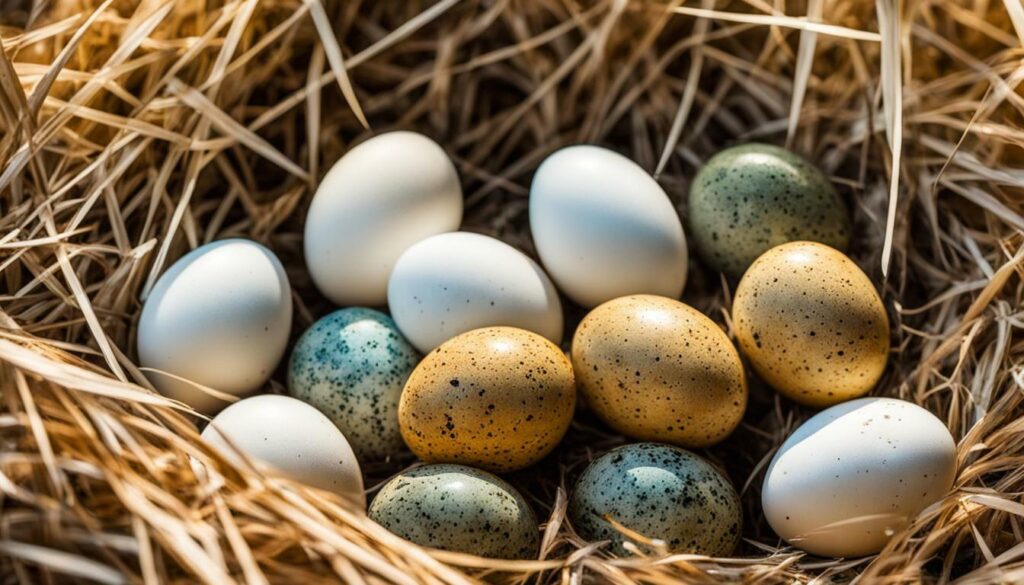
So, there you have it – a glimpse into the captivating world of ducks and their eggs. From the rhythm of egg-laying to the secrets hidden within the shell, these curious egg facts shed light on the wonders of nature. Whether you’re an avid bird lover or simply curious about the natural world, these fascinating tidbits will surely leave you with a newfound appreciation for the delicate miracle that is the duck egg.
| Egg Facts | Fun Trivia |
|---|---|
| Number of eggs laid by ducks per day | One |
| Number of eggs laid by geese every day and a half | One |
| Number of days for incubation | 21-31 |
| Famous novelty architecture | The Big Duck |
| Location of The Big Duck | Riverhead, New York |
Conclusion: A Fascinating Journey Comes to an End
As our riveting journey comes to a close, take a moment to reflect on the incredible facts and wonders we have unraveled about ducks and their eggs. Throughout this captivating exploration, we have uncovered a world of fascinating insights into the unique characteristics and behaviors of these remarkable waterfowl.
From the miracle of incubation, where duck embryos undergo an astonishing development process within their eggs for a period of 21 to 31 days, to the intriguing technique of candling, which allows us to observe the growth and changes within the eggs, we have witnessed the marvels of life in its early stages.
Our ears have been treated to the symphony of hatchlings, with the delightful clicking and peeping sounds produced by the ducklings shortly before they break free from their protective shells. These tiny creatures herald the arrival of new life and add to the already profound wonder of the egg-laying process.
Our journey has also taken us to the iconic Big Duck, a magnificent example of novelty architecture that was originally built in 1931 as a shop to sell ducks. Having been relocated three times, it now stands as a beloved tourist attraction in Riverhead, New York, reminding us of the rich history and cultural significance attached to these remarkable creatures.
As we delve into the intricacies of duck egg production, we learn that ducks lay one egg per day, while geese and swans follow their own unique schedules. Understanding the reproductive abilities of ducks, and how their lifespan influences egg production, gives us a deeper appreciation for the delicate balance and rhythm of nature.
Duck eggs, with their distinct characteristics, set themselves apart from those of other waterfowl species. Comparing them to goose eggs and swan eggs unveils the subtle differences that make each species truly remarkable in its own way.
The quest for knowledge has also led us to explore how ducks move their eggs, offering insights into their protective instincts and the reasons behind their actions. Our exploration has even taken an unexpected turn as we delve into the behavior of ducks when faced with dead eggs and their intriguing decision to sit on them.
Lastly, we’ve uncovered curious and lesser-known facts about duck eggs, adding an extra layer of awe to the already captivating world of these incredible waterfowl.
So, as our journey concludes, we bid farewell to the fascinating world of ducks and their eggs, but our newfound knowledge and admiration for these creatures will continue to inspire and amaze us. Ducks have shown us that beneath their delicate shells lies a world of wonder waiting to be discovered.
FAQ
How many eggs do ducks lay per day?
Ducks lay one egg per day.
How often do geese lay eggs?
Geese lay one egg every day and a half.
How often do swans lay eggs?
Swans lay one egg every two days.
How long does incubation last?
Incubation lasts between 21 and 31 days.
What is candling?
Candling is a technique used to observe the development of duck embryos inside their eggs.
What sounds do ducklings make before hatching?
Ducklings produce clicking and peeping sounds inside the eggs shortly before hatching.
What is the Big Duck?
The Big Duck is a famous novelty architecture that was originally built in 1931 as a shop to sell ducks. It is now a tourist attraction in Riverhead, New York.

